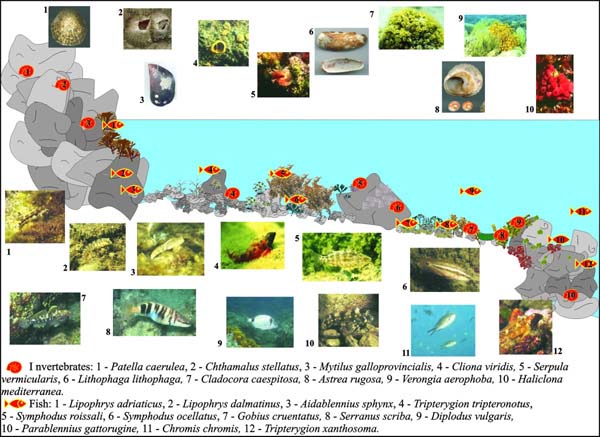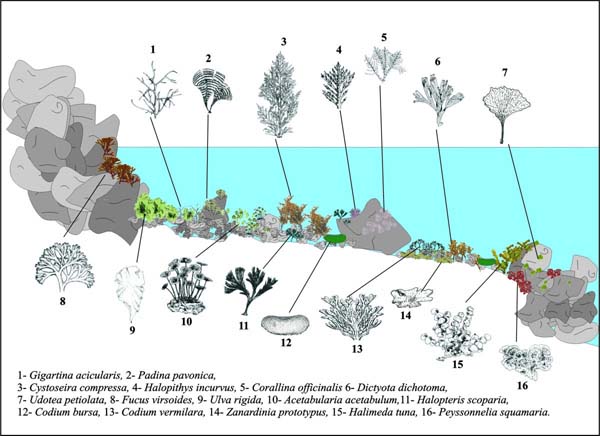The importance of diving in the study of marine biodiversity in the
shallow Slovenian Sea (Gulf of Trieste)
Martina
Orlando
Marine
Biological Station Piran,
National Institute of Biology,
Fornače
41, 6330 Piran,
Slovenia
The
Slovenian sea represents the southern part of the Gulf of Trieste, which
is the northernmost point of both the Adriatic and the Mediterranean
Seas. It is a shallow semi-enclosed gulf with the maximum depth of ca.
33 m in waters off Piran. Slovenian coastline is approximately 46 km
long.
The
research on flora and fauna in the Gulf of Trieste has a centennial
tradition, however there are several gaps in the knowledge of different
taxonomic groups. Few years ago a research group was established at the
Marine biological station in Piran, in order to assess the status of
fauna, flora and habitat types of the Slovenian coastal sea, to obtain a
comprehensive inventory and to identify the factors that are having (or
might have) negative impact on the coastal and marine biodiversity.
The
collection of data for this project is carried out primarily by SCUBA
diving; on linear transects
along the coastal belt. The field work is recorded with a photo- and
video-camera. These techniques have been choosen because they are
non-destructive methods; samples are collected only when the
identification of organisms is not possible under water.
 0 0 |
Figure 1. Some inhabitants of the
Slovenian coastal area (from: Lipej et al., 2000).
The
research group has a particular interest in the assessment of
infralittoral fish diversity. The accurate estimation of fish population
is a current ecological problem, as long-term surveys of fish
assemblages are being developed to study the impact of man-induced
changes or to determine the protection status in restricted zones
(Harmelin-Vivien & Francour, 1992). With
the increasing number of marine protected areas in the Mediterranean,
traditional fishing devices –prohibited in protected zones – could
be well supplanted by visual counts methods.
Marine
small-size fish, that by definition reach a maximum size of only 10 cm,
have been the object of ecological investigations in several region of
the world (Gibson, 1982). These fish escape from commercial fishing
gears and remain undisturbed especially on rocky substrata. Therefore,
it was not surprising that several gobiid and blennioid species of small
size were described for the first time during the last 25 years from the
European part of the Mediterranean Sea (Miller, 1986; Zander, 1990). The
SCUBA techniques revealed that the infrequent capture of small fish in
the past is not always an indication of true numerical rarity in the
ecosystem. On the contrary, the introduction of such techniques has
recently repeatedly demonstrated the abundance and diversity of small
fish in the Mediterranean Sea (Ahnelt & Kovačić, 1997).
The
blennioids of the Adriatic Sea have been discreetly investigated and
from the check-list of Pallaoro & Števčić (1989) it can
be seen that in the Adriatic area 20 species (1 Clinidae, 16 Blenniidae
and 3 Tripterygiidae) have been established with certainty. Although few
descriptions of the blennid fauna of the Northern Adriatic are
available, there was still a lack of knowledge regarding the species
inhabiting the Slovenian coastal waters. With the SCUBA diving Lipej
& Richter (1999) recorded eighteen blennioids species toward the
only 6 blennioids mentioned in the first report for this area, when
samples were mostly collected with trawling nets (Matjašič et al., 1975).
 |
Figure 2. Some more inhabitants of the
Slovenian coastal area (from: Lipej et al., 2000).
The
first survey of species from the family Gobiidae in the Adriatic Sea
were in the last century, done by Steindachner and Kolombatović
(Kovačić, 1994). Recently, the interest for this family has
increased again. New gobiid species have been described (Kovačič,
1995, 1999; Kovačić & Miller, 2000), so the number of
gobiids recorded in the Adriatic area has risen to 45.
With
the SCUBA diving techniques it will be possible to have in a few years a
quite complete inventory of the flora and the fauna of the Slovenian
Sea, which includes also the nonindigenous species that are constantly
reaching our waters. Although only a minor research of this kind has
been carried out in the Adriatic Sea, scientists have recorded cases of
introductions of alien species that could badly affect the indigenous
ecosystems. SCUBA diving is one of the most appropriate techniques to be
used to monitor the spread of nonindigenous species, in order to
understand the impact they have once they are established in the new
area, and take the right measures to protect the natural biodiversity of
local ecosystems.
References
Ahnelt H. & Kovačić M., 1997. A Northern Adriatic
population of Thorogobius
macrolepis (Teleostei: Gobiidae). Cybium,
21 (2). 149-162.
Gibson R.N., 1982. Recent studies on the biology of intertidal fishes. Oceanogr.
Mar. Biol. Ann. Rev., 20, pp. 363-414.
Harmelin-Vivien M. L. & Francour P., 1992. Trawling or Visual
Censuses? Methodological Bias in the Assessment of Fish Populations in
Seagrass Beds. P.S.Z.N.I: Marine Ecology, 13 (1): 41-51.
Kovačić M., 1994. Contribution to the knowledge of gobies,
Gobiidae (Pisces, Perciformes) in the Rijeka Bay, Adriatic Sea. Periodicum Biologorum, Vol 96, No. 4, 463-465.
Kovačić M., 1995. Gobius
roulei De Buen, 1928 (Pisces, Teleostei, Gobiidae), a fish new to
the Adriatic fauna. Nat. Croat.
Vol. 4., No 4, pp. 173-184, Zagreb.
Kovačić M., 1999. Gammogobius
steinitzi Bath, 1971, a fish new to the Adriatic Sea. Nat. Croat. Vol. 8., No 1, pp. 1-7, Zagreb.
Kovačić M. & Miller P. J., 2000. A new species of Gobius
(Teleostei: Gobiidae) from the Northern Adriatic Sea. Cybium,
24 (3): 231-239.
Lipej L. & Richter M., 1999. Blennioides (Blennioidea) of the
Slovenian coastal waters. Annales 15/99,
pp. 15-24.
Lipej L., Orlando M. & Makovec T., 2000. Pestrost življenja
piranske Punte: naravna dediščina. Piran: Morska biološka
postaja, Nacionalni inštitut za biologijo. 16 pp.
Matjašič J., Štirn J., Avčin A., Kubik L., Valentinčič
T., Velkovrh F. & Vukovič A., 1975. Flora in favna severnega
Jadrana. Prispevek 1. Slovenska
akademija znanosti in umetnosti. Ljubljana, 54 pp.
Miller P.J., 1986. Gobiidae. In: P.J.P. Whitehead, M.L. Bauchot, J.C.
Hureau, J. Nielsen & E. Tortonese (Eds.), Fishes of the
North-Eastern Atlantic and Mediterranean. UNESCO, Paris: 1019-1085.
Pallaoro A. & Števčić Z., 1989. A check-list of species
of Adriatic Blennioidea (Pisces, Teleostei, Perciformes). Studia Marina, N. 20, Kotor, Yugoslavia.
Zander C. D., 1990. The distribution and feeding ecology of small-size
epibenthic fish in the coastal Mediterranean Sea. 21 EMBS, 369-376.
|
